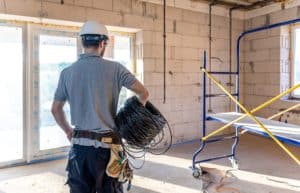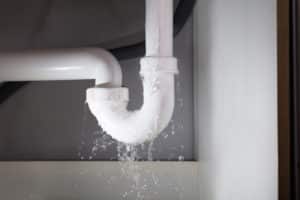The beginning of the coronavirus pandemic caused the temporary closure of many businesses and services. However, as the months go by, many of these services need to be resumed.
Some businesses are taking precautions such as limiting the number of customers inside a building, requiring customers to wear face masks, and limiting store hours to give staff more time to thoroughly sanitize surfaces.
However, some professionals, like contractors, face slightly different circumstances when returning to work and so have to take extra precautions.
Contractors often work inside of homes or occupied buildings. While the pandemic may be an opportune time for building renovations to be completed while employees are working remotely, it’s less easy for a family to completely vacate a home while having the contracted work of a plumber, electrician, or other home service provider being performed.
This article gives insight into the various COVID-19 precautions (based on recommendations from the CDC specifically given for contractors and construction workers) that contractors can implement to ensure both safe interactions for customers and a safe and healthy work environment for their employees.
COVID-19 Overview
To give a brief overview, COVID-19 is an infectious respiratory illness. While new information on the virus is constantly surfacing, the common symptoms identified include a dry cough, fever, difficulty in breathing, and fatigue. However, some people can become infected but remain asymptomatic.
According to the World Health Organization, the virus spreads through the respiratory droplets from an infected person when they talk, sneeze, or cough, and through contaminated surfaces and objects.
Older people and those with underlying health conditions such as cardiovascular diseases, diabetes, respiratory illnesses, and cancer are at a higher risk of being severely affected by the virus.
Creating A Safe and Healthy Work Environment
Contractors such as electricians, plumbers, and construction workers often have to work directly within homes or share equipment on populated worksites. This creates a higher likelihood of being exposed to infected persons, which can in turn cause the spread of the illness to coworkers and families.
To create and maintain a safe work environment, all employees should follow basic hygiene and physical distancing guidelines, as well as occupation-specific recommendations.
Basic Hygiene Recommendations
The CDC recommends hygiene and distancing practices for everyone, especially those who are returning to work. Recommendations include the following:
- Practice physical distancing by keeping a distance of at least six feet between workers. This distance should prevent workers from coming into contact with infected droplets.
- Wear a cloth face mask or covering, especially if it is difficult to maintain a six-foot distance from others.
- Cultivate “hand hygiene” by washing hands thoroughly with soap and water for at least 20 seconds after sneezing or coughing, blowing your nose, before putting on gloves and after taking them off, after touching your face mask, and before and after touching shared tools and surfaces. If soap and water isn’t readily available, use hand sanitizer that is at least 60% alcohol.
- Frequently disinfect all shared items or surfaces, such as tools, machines, shared vehicles, door handles, ladders, etc. Disinfection should take place not only at the beginning and ends of shifts, but also after employees use shared tools.
- Employees who have indicated that they are unwell should be allowed, and encouraged, to stay home in isolation until their doctor approves regular contact.
Recommended Precautions for Contractors and Your Customers
For administrative staff or others who work in an office, you can reduce the risk of spreading the virus among your workers by limiting the use of shared spaces like a break room and creating barriers between workers to practice physical distancing.
However, on a job site, this may be difficult or impossible to do. Some recommendations for limiting contact and risk of infection on job sites include:
- Reorganize the usual working schedule to introduce extra shift hours, allowing employees to work with fewer people onsite at one time.
- Limit sharing tools as much as possible.
- Cancel or postpone in-person meetings, especially if it would require a large group gathering.
- If possible, install shields or barriers such as plexiglass between workstations, or stay at least six feet away from others.
You should follow these guidelines when it comes to interacting with customers, as well. That’s why these guidelines are applicable to not only large contractor businesses, but even organizations as small as one person.
Limit face-to-face contact with customers as much as possible by moving any parts of the process that can reasonably be done online, such as signing contracts, to remote platforms.
However, clients will most likely want to meet to go over options and be able to visualize plans before making decisions for their home or building. If you must meet with clients, remain six feet apart, wear a mask, and limit contact with shared surfaces.
What If an Employee Gets Infected with COVID-19?
In the unfortunate event that a worker contracts the virus, they should stop working immediately and self isolate. The infected person should alert people they were in contact with of their diagnosis. These identified persons should then be isolated and tested following local COVID-19 testing guidelines. However, if precautions are followed correctly, there will likely be fewer employees infected.
How to Limit the Effects of COVID-19 on Your Business’s Productivity and Finances
Should one or several employees of your company become infected, a decrease in the available workforce could cause a slowdown in the day-to-day activities of your company. Not only could your workforce be affected, but the pandemic has been disrupting supply chains across many industries due to bans on international travel and temporary business closures.
Such a situation can place a temporary strain on the company’s ability to make its usual income. That’s where contractor insurance comes in. With the right builder’s income coverage insurance, loss in revenue can be covered.
COVID-19 is also proving the importance of workers’ compensation insurance. If an employee contracted COVID-19 through work done on a work site or even at the workplace, worker’s compensation insurance can help them cover costs, as it covers both injuries and disease that occur on the job, and it could also protect you from being held accountable.
Liability insurance is another useful and necessary option, as it protects you from damages caused to third parties or property due to your work. Although legalities surrounding COVID-19 are still emerging, this type of insurance should protect you against claims of third parties such as a client whose home you worked in who afterward contracted the virus.
To increase the protection and safety of both workers and customers, contractors must ensure that these COVID-19 precautions are taken and that they secure contractor insurance with adequate coverage to protect against revenue loss, liability claims, and to aid employees who may fall sick.




